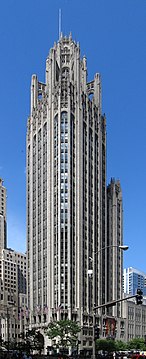John Mead Howells
John Mead Howells | |
|---|---|
Beekman (Panhellenic) Tower, Daily News Building |
John Mead Howells,
Early life and education
Born in Cambridge, Massachusetts, the son of author William Dean Howells, he earned an undergraduate degree from Harvard University in 1891 and completed further architectural studies there in 1894 before studying at the École des Beaux-Arts, in Paris, where he earned a diploma in 1897.
Career
Howells moved to New York City and founded the architectural firm Howells & Stokes with Isaac Newton Phelps Stokes, who had also studied at the École. The partnership designed such works as St. Paul's Chapel at Columbia University and Stormfield, an Italianate villa commissioned by Samuel Clemens,[1] a longtime friend of his father.[2]
Ending the partnership in 1913, Howells would focus his practice on office buildings in the Art Deco style, some of which he completed with Raymond Hood, whom he had met during his time at the École, and whom he had invited to become a partner when he was selected to enter the Chicago Tribune building competition in 1922. These projects include the prize-winning design of the Tribune Tower in Chicago and the American Radiator Building and Daily News Building in New York City. Howells also designed the Beekman Tower in New York and the plan for the University of Brussels in Belgium in 1922 at the request of U.S. Secretary of Commerce Herbert Hoover. Howells's institutional works include the Engineering Quadrangle at Pratt Institute, built in phases from 1909 to 1928; Memorial Hall at Pratt Institute in 1927; and Willoughby Hall at Pratt Institute in 1957.
Howells served as president of the
Gallery
-
Engineering Quadrangle, Pratt Institute's
-
Tribune Tower in Chicago
References
- ^ "The History of Stormfield" (PDF). Mark Twain Library. Archived from the original (PDF) on 2017-02-10. Retrieved 2014-05-14.
- ISBN 9780520250000. Retrieved 2014-05-21.
- ^ Thomas E. Luebke, ed., Civic Art: A Centennial History of the U.S. Commission of Fine Arts (Washington, D.C.: U.S. Commission of Fine Arts, 2013): Appendix B, p. 546.




